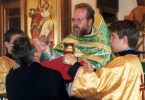
by Mark Pattison
Everything old is news again.
Just as Jesus said, “The poor you will have with you always,” it seems as if the same news subjects, with different dimensions, keep cropping up over the past century.
Here we examine just four topics that have had staying power over the lifespan of CNS’ 100 years. The excerpts below are from stories published by Catholic News Service under its original name of NCWC News Service, which was founded in 1920 by the U.S. bishops’ National Catholic Welfare Council, later Conference. (NCWC was the precursor to today’s U.S. Conference of Catholic Bishops.)

— Immigration: The quest to enact more just and humane immigration policies has a long history in Catholic circles. So too has the quest to fix flaws in laws already passed.
An NCWC News Service story from Jan. 27, 1927, headlined “CHANGES MADE IN IMMIGRATION ACT: Amendments Aim to Remedy Injustices Worked By Present Law” noted how “the House Immigration Committee has this week been considering the addition of three more clauses to the resolution to correct some injustices in the [Immigration] Act of 1924.”
One change would give “a woman citizen of the United States with an alien husband . . . the same rights enjoyed by a man citizen with an alien wife,” the law said. Another change would give “nonquota” status to would-be immigrants from U.S.-administered territories such as the U.S. Virgin Islands. The 1924 law gave such status to “immigrants born in North, South and Central America and other specialized places.”
Today, federal immigration policy remains controversial, including billions spent to build a wall along the U.S.-Mexico border, telling those seeking asylum to remain in Mexico until hearings can be held by overworked immigration judges, and slashing the number of refugees admitted to the United States since 2017. Newly elected President Joe Biden, hours after he was inaugurated Jan. 20, 2021, signed a half dozen executive orders on immigration, including stopping construction of the wall.
— Economy: When Franklin D. Roosevelt took the presidential oath of office in 1933, the United States was already deep in the throes of the Great Depression. The Roosevelt administration’s New Deal tried all sorts of programs to reform the economy and give people work. Some fared better than others, but the unemployment rate only dipped below 15% briefly during the decade. It peaked at 25% in 1933, FDR’s first year in office.
On Christmas Day 1933, NCWC News published an article: “SOCIAL JUSTICE TO HOLD STAGE AS CONGRESS MEETS,” which dwelt on bills being considered to spread the wealth while not killing the goose that lays the golden egg.
“The NRA (National Recovery Administration) is debating the question of requiring all industrial and trade concerns under code administration to file statements of their financial condition In order that their profits may be kept under scrutiny and, presumably, scaled down in one way or another, if they are too high. The general tendency of the ‘new deal,’ therefore, appears to be to put as many obstacles as possible in the way of the accumulation of wealth, which has been so often under attack as one of the evils of the existing social order,” said the NCWC article.
“The converse of this general policy is also true — to diffuse wealth more widely and divert a larger amount to the fanner, the workman and those who stand most in need of it,” it continued. “Abnormally large incomes, salaries end dividends are in the way of being scaled down by taxation and regulation: wages, returns to the growers of food products and direct benefits to the needy are to be raised upward.”
It said the “chief difficulty that is being encountered in the application of this policy is to make” the accumulation of too much wealth “difficult without impairing the production of wealth.”
In recent years, much attention has been paid to “the 1%,” or the highest-earning U.S. households, and the income and wealth inequality that result. The U.S. economy is in an 11-year growth mode and unemployment is low, yet more than 40 million Americans continue to live in poverty, according to Poverty USA, an initiative of the Catholic Campaign for Human Development.
— War and peace: The U.S. bishops founded the National Catholic War Council in 1917 to coordinate Catholic response to the war, including recruitment of military chaplains and a focus on displaced people and child welfare; they also wanted to show Catholics were every bit as American as the rest of the country. After the armistice, the bishops wanted a permanent presence in the nation’s capital to promote Catholic interests. In 1919, the war council became the National Catholic Welfare Council. In 1922, “council” was then changed to “conference.”

In an era of peace, and of a newly acknowledged U.S. strength, the church started forming organizations to address the needs of its own growing numbers. The NCWC News Service was one.
The news service, even in the midst of World War II, kept an eye open for the prospect of peace and how it could be achieved. A Nov. 1, 1943, dispatch datelined Toronto quoted a Father C.J. Foran of St. Anthony’s Pro-Cathedral in Edmonton, Alberta, as saying said popes who reigned during both world wars brought their influence to bear in the cause of peace.
“What the whole world does not know is that Pope Benedict’s (XV) seven-point peace program was later incorporated without mention of its origin into Woodrow Wilson’s now famous Fourteen Points,” the priest said.
As for Pope Pius XII, Father Foran said that while he would not “assert that the pope inspired the Atlantic Charter,” the pope had issued a Peace Plan “over two years before the historic meeting between (Winston) Churchill and Roosevelt took place,” and he felt the papal plan had influenced, “if not actually inspired” the charter.
In our own lifetimes, popes have worked and pleaded for peace. St. Paul VI is still quoted to this day for his instruction, “If you want peace, work for justice.” While no conflict has ever been declared World War III, there are enough armed skirmishes that vex leaders and citizens of the participating nations and throughout the world. The end of World War II was hastened by the dropping of two nuclear bombs on Japan.
— Education: The postwar years represented a zenith of sorts in Catholic education. The baby boom took hold, and parishes, it seems, could not build schools fast enough to accommodate all of the children whose parents wanted them to have a Catholic education. Women religious, whose numbers were still abundant and who then toiled for next to nothing, staffed the schools.
A May 12, 1947, NCWC article took note of anti-Catholic commentary in Alexandria, Louisiana, that claimed Catholics did not want to pay taxes for public education, and that 2.5 million Catholic children were being educated in Catholic schools. Anti-Catholic bigotry in education was nothing new; a failed Oregon effort in the 1920s would have forced all children to attend public schools. Catholics, when given a choice, often picked Catholic schools for their kids because, while there was prayer in the public schools, it was Protestant-based.

A Knights of Columbus council in Alexandria lambasted the report, which appeared in the Scottish-Rite News Bulletin, as “propaganda,” and noted that, as recently as 1945, only 2.3 million kids went to Catholic schools.
NCWC News also reported on how some U.S. Catholic bishops were way ahead of the Supreme Court’s 1954 Brown v. the Board of Education ruling that desegrated schools. For example, then-Archbishop Joseph E. Ritter went to St. Louis in 1946 and instructed all pastors that year to end racial segregation in schools.
The high-water mark for enrollment in Catholic schools was 1965, when 5.2 million children were in Catholic schools, according to figures supplied by the National Catholic Educational Association.
“The next two decades saw a significant diminishment in both number of schools and enrollment. In the 1990s, the rate of school closures declined and total enrollment rose steadily,” said NCEA spokeswoman Margaret Kaplow. “But, the past decade has seen schools in the central cities experience sharp declines in enrollment due to downturned economy, demographic changes in those areas and sharp increases in tuition.”
For 2019-20, nearly 1.74 million students are enrolled, 19.1% of them non-Catholics, 21.8% members of racial minorities and 18.5% of the student body Hispanic. There are 6,183 Catholic schools, and 1,760 of them have a waiting list for admission, according to the NCEA. Ten new schools opened, while 98 others either consolidated or closed.






